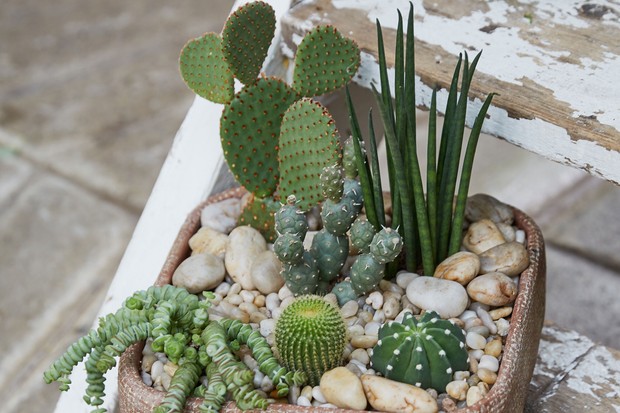
Closely related to the more common mother-in-law’s-tongue (Dracaena trifasciata), African spear plant (Dracaena cylindrica) is a slow-growing succulent plant, with tall, smooth, spear-like foliage with subtle grey-green variation. Hailing from Angola, it’s typically grown as a house plant in the UK but can be moved outdoors for summer. It thrives in temperatures between 15°C and 23°C, but can tolerate short periods of temperatures as low as 10°C.
Recently all plants in the Sansevieria genus were reclassified into the Dracaena genus, so Sansevieria cylindrica is now known as Dracaena cylindrica.
How to grow Sansevieria cylindrica
Dracaena cylindrica is easy to grow and needs very little attention. Its spear-like foliage stands tall and makes a striking foil for more lush-leaved plants. If you’re lucky, a flower spike may appear from the base of the plant, covered in tiny white blooms.
Where to grow Sansevieria cylindrica
African spear plant growing with cacti and succulents in a drought-tolerant planter. Getty Images
Grow Dracaena cylindrica in bright light out of indirect sunlight, in an averagely humid spot – there’s no need to keep it in your bathroom. It’s a fantastic choice for air purification – studies have shown its foliage can filter airborne toxins such as benzene (associated with glues, wax and detergents), and formaldehyde (found in household products, cigarette smoke and smoke from wood burning stoves), so you might want to grow it in a bedroom or living room where there are lots of potential pollutants floating about.
How to care for Sansevieria cylindrica

Repotting African spear plant. Getty Images
Water infrequently, allowing the compost to completely dry out between waterings. Avoid letting the plant sit in water as this may cause root rot. There’s very little need to feed Dracaena cylindrica, but a weak solution of cactus feed once a month may beneficial.
How to propagate Sansevieria cylindrica
Dracaena cylindrica forms clumps, which can be easily divided to make new plants. Wait until the stems are around 10cm tall before simply removing the plant from its pot, gently separating a clump of stems from the main rootball, and then potting both clumps into pots with fresh, peat-free compost. Water well and allow to drain.
Growing Sansevieria cylindrica: pests and diseases
Dracaena cylindrica is susceptible to common house plant pests such as aphids, vine weevil, and mealybugs. Check the leaves regularly and remove insects as soon as you see them.
Dracaena cylindrica is not prone to diseases but can suffer in high humidity or with too much water. Over-watering can lead to yellow and swollen leaves, while discoloured leaves could be down to too much humidity. In both instances, move the plant into a less humid room and let the compost dry out completely before watering again.
Advice on buying Sansevieria cylindrica
- Sansevieria cylindrica may be available from garden centres but you’ll have the best chance of finding it online
- Ensure you have the right growing conditions for Sansevieria cylindrica – a light spot out of direct sunlight with average humidity is perfect
- Always check plants for signs of disease or damage before planting
